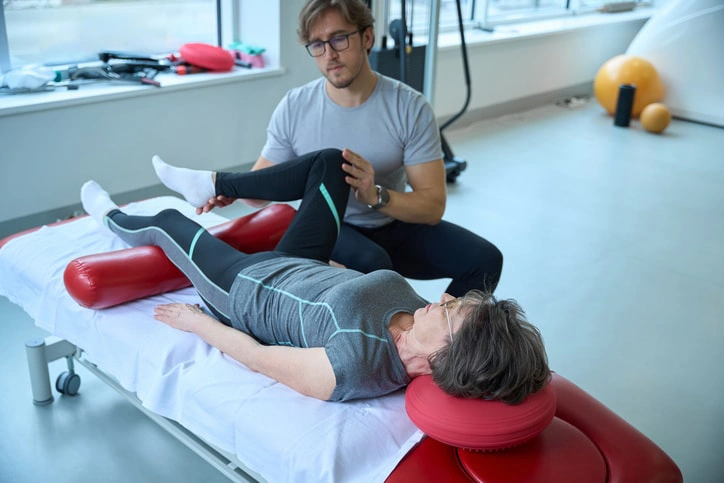Table of Contents
- What's the Difference Between Occupational Therapy and Physiotherapy?
- Key Differences Between Occupational Therapy and Physiotherapy
- Responsibilities of Occupational Therapists
- Do I Need an Occupational Therapist or a Physiotherapist?
- Does the NDIS Fund Occupational Therapy and Physiotherapy?
- Conclusion
- How can we help?
What's the Difference Between Occupational Therapy and Physiotherapy?
It’s not unusual for occupational therapy and physiotherapy to be confused, especially as they can both play important roles in physical rehabilitation and improving daily functions. However, they do have very different purposes and approaches and it’s helpful to understand the distinction.
What is Occupational Therapy?
Occupational therapy (OT) is a healthcare treatment that focuses on helping people with physical, cognitive, or developmental disabilities or injuries to perform day to day tasks independently.
Occupational therapy is mostly concerned with how well a person is able to complete functional tasks and participate in everyday activities, aiming to maximise independence and overall well-being.
Occupational therapists treat the whole person, using a diverse range of techniques to overcome barriers, improve function and enable people to live their life and participate at home, school or work.
Occupational therapy interventions focus on practical solutions, for example, an occupational therapist may teach emotional regulation or sensory processing strategies, suggest environmental modifications, or provide assistive equipment.
What is Physiotherapy?
Physiotherapy is a healthcare treatment that focuses on treating patients with issues caused by physical injuries or medical conditions, with a customised treatment program tailored to the patient’s specific needs.
Physiotherapy techniques can restore muscle functions and reduce pain, potentially avoiding expensive medication or surgery.
Physiotherapists assess patients’ mobility and motor skills, focusing on posture, movement, safety, and alignment. They also help prevent further injuries.
Physiotherapy treatment techniques can include manual therapy (such as stretching, soft tissue release and join mobilisation), designing treatment programs and working on exercises to strengthen muscles, improve flexibility and balance.
What About Physical Therapy?
You may have also heard the term ‘physical therapy’. In Australia, this is more or less interchangeable with ‘physiotherapy,’ although it can refer to a more exercise-based approach, rather than manual therapy, like massage or manipulation, because this is how the term ‘physical therapy’ is used in Canada and the USA.

Key Differences Between Occupational Therapy and Physiotherapy
Occupational therapy focuses on the ability to participate in daily activities, while physiotherapy concentrates on enhancing movement and function.
Occupational therapy addresses physical, cognitive, social, and psychological challenges, whereas physiotherapy targets physical limitations only.
Occupational therapy aims to maximise independence and overall well-being, whereas physiotherapy aims to restore physical capabilities.
Overlapping Goals and Techniques
While occupational therapy and physiotherapy have differing aims and approaches, there are still plenty of similarities, and areas of overlap between the two, such as:
Both occupational therapy and physiotherapy aim to improve mobility, functional abilities and daily life.
Both therapies involve personalised treatment plans.
Both therapies employ various techniques and strategies, including exercises, activities, and other methods.
Both educate people on the healing process of the human body and how to prevent and avoid injuries.
Both assist people with improving their ability to perform daily activities, such as self-care tasks, through training and education.
In some cases, patients may start with a physiotherapist and progress to an occupational therapist.
Qualifications and Training
A HLT33015 Certificate III in Allied Health Assistance will qualify you to work as an occupational therapy assistant or physiotherapy assistant in Australia.
Occupational therapists and physiotherapists undergo extensive training to assess individuals’ needs, considering physical, cognitive, social, environmental, and psychological factors.

Responsibilities of Occupational Therapists
If you have a physical, developmental or cognitive disability, an occupational therapist can help you to develop the skills you need for daily living and work.
Occupational therapists take a holistic approach to look at your role and situation and recommend environmental alterations or mobility aids.
Occupational therapists work on
fine motor skills, such as using smaller muscles of the hands, to enable individuals to perform tasks such as writing, doing up buttons or using cutlery
gross motor skills, such as running, jumping and coordination social skills, to interact with others and develop relationships
emotional regulation, including managing stress or anxiety
organising and executing tasks like catching public transport or preparing meals
sensory processing, recognising and processing information from taste, touch, sound, smell, body awareness and movement.
Occupational therapy is broader than physiotherapy.

Responsibilities of Physiotherapists
Physiotherapists work closely with clients to develop individualised treatment plans to improve movement, strength, and range of motion while managing pain.
A physiotherapist focuses on a biomechanical perspective and is most concerned with gross motor skills and improving mobility.
Physiotherapy interventions include targeted exercises, hands-on therapy and manipulation (such as aligning bones and joints), and modalities.
Physiotherapists only treat physical conditions.
Do I Need an Occupational Therapist or a Physiotherapist?
When to See an Occupational Therapist
Occupational therapy is recommended when a condition or illness affects your ability to perform daily tasks.
Occupational therapy can be helpful for health conditions as diverse as stroke, spinal cord injury, mental health illnesses, autism spectrum disorder, and developmental delay.
Occupational therapy can help improve your ability to perform daily tasks and improve your quality of life.
When to See a Physiotherapist
Physiotherapy is often recommended when a condition affects movement or range of motion, such as knee replacement surgery, stroke, or other injuries or illnesses.
Physiotherapy can help with increasing mobility, strength, and range of motion.
Can You Use Occupational Therapy and Physiotherapy at the Same Time?
Yes – collaboration between an occupational therapist and physiotherapist can lead to better outcomes for individuals with complex needs.
Both therapies can work together to address physical, cognitive, and psychological challenges.
Collaboration can help individuals achieve their goals and improve their overall well-being.
For example, someone with a physical disability might work with a physiotherapist to build muscle strength. They would also see an occupational therapist to practice fine motor skills, for daily tasks such as bathing, dressing, and walking, and source aids to make these tasks easier to do independently.

Does the NDIS Fund Occupational Therapy and Physiotherapy?
Both occupational therapy and physiotherapy can be covered under the NDIS, depending on what’s been approved in your NDIS plan.
Funding for occupational therapy or for physiotherapy may be included in your NDIS plan, if you need it due to the regular impact of your disability (not for a health condition) and it also meets all the other NDIS funding criteria.
Both of these therapies come under the funding category Capacity Building (Improved Daily Living). If you have available funds in this category, you will be able to use these funds to pay for occupational therapy or physiotherapy sessions, with no out of pocket expenses.
Find out more about using your NDIS plan to access occupational therapy.
Conclusion
Occupational therapy and physiotherapy are two distinct forms of therapy that work together to help individuals with disabilities or injuries.
Understanding the key differences between OT and PT can help individuals choose the right therapy for their needs.
Collaboration between occupational therapists and physiotherapists can lead to better outcomes and improved overall well-being.
How can we help?
Goal Coach’s occupational therapists are experienced at working with children and adults facing a wide range of challenges.
With our virtual appointments, location is no barrier: we can work with you and/or your child, from wherever you are in Australia.
Goal Coach has no waiting lists and you can even get started with a 15-minute free chat to make sure the service is right for you.










